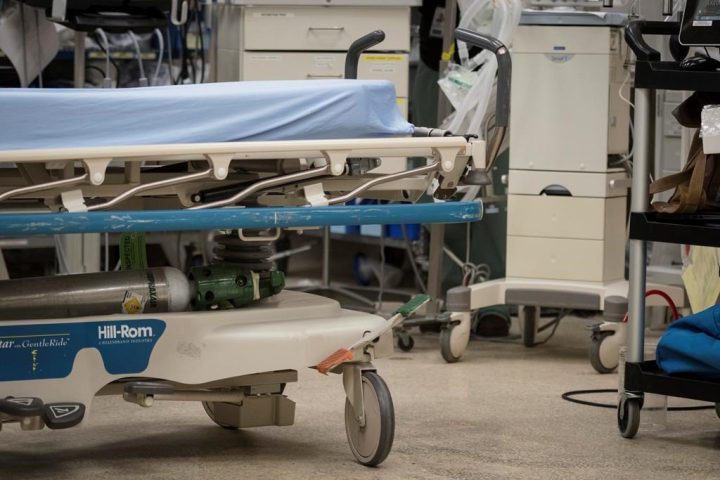Doug Walsh remembers being rushed to the emergency department in his rural Ontario community when he had a stroke a decade ago and credits the urgent care he received with saving his life.

But the 79-year-old who lives in Chesley, Ont., now worries what would happen if another medical emergency strikes, given that the local hospital has shut its ER until December and his wife can’t drive.
“Right now, there is no plan B or plan C, we have nothing,” he said in an interview. “If I can’t drive and the ambulances can’t get here, then I don’t even want to think of the results.”
The South Bruce Grey Health Centre, which runs the Chesley hospital, closed the community’s emergency room in early October, citing “critical nurse shortages.”
The decision sparked outrage and fear among roughly 1,800 local area residents, with many calling on the province to provide more funding to support rural health systems particularly since those living in such communities have fewer hospital options than city dwellers.
The emergency department’s prolonged closure – which comes as several Ontario hospitals have had to shut their ERs for periods of time this year – has highlighted the challenges rural hospitals in particular face as they struggle with nurse shortages, a smaller pool of staff to move around when resources are stretched, and challenges retaining employees.
The situation has left some residents, like Walsh, wondering about the future of rural hospitals that area locals rely on.
“We are beginning to wonder because we are such a small hospital, are they going to try to eliminate us altogether,” he said.
The chief physician at the Chesley hospital said the hospital’s board decided to shut down the ER for a prolonged period of time after a series of frequent and unpredictable closures related to nurse shortages.
Dr. Jacqui Wong said the hospital had to deal with nightly closures for an extended period of time in 2019. The situation improved for a while but then the pandemic hit, straining staff and hospital resources, she said. The unpredictable closures of the ER that followed were “really bad for the community,” she said.
“They didn’t know whether we are open or closed. There was nothing consistent,” she said. “The decision was made to close on a more consistent basis to make it safer for the community, so they don’t show up with emerg closed.”

Get weekly health news
The nurse shortage at the heart of the ER closures was so severe that one sick call could cause significant repercussions across the hospital, Wong said, noting that Chesley has a smaller ER, which means fewer staff resources to move around.

The South Bruce Grey Health Centre said the nurse shortage at the Chesley hospital continues, despite a “considerable effort” to hire and retain staff. The decision to close the emergency department for eight weeks was made so the hospital can develop a longer-term solution, it said, although it did not elaborate on what those solutions might be.
A similar situation has been playing out at the Glengarry Memorial Hospital in Alexandria, Ont., a rural community about an hour from Ottawa.
The hospital had to close its emergency room during night shifts for the first time in July for over two weeks, and has been experiencing temporary shutdowns since then. Like the hospital in Chesley, the ER closures are related to nurse shortages.
“This is the first time this has happened, and it is very serious, and we are doing everything possible to avoid those closures,” said Robert Alldred-Hughes, the hospital’s president and chief executive officer.
Alldred-Hughes said four new nurses are expected to join the hospital in November, which he hoped could resolve the issue to an extent.

Dr. Alan Drummond, an emergency physician at the Perth and Smiths Falls District Hospital, which had to fully close the ER at its Perth, Ont., site for three weeks this summer, said the situation in rural hospitals is “fragile.”
“We are functioning at a bare minimum level and there is a lot of anxiety going into the coming winter season as to what is going to happen,” he said.
Drummond, who is also the co-chair of public affairs for the Canadian Association of Emergency Physicians, said 17 out of 160 emergency departments have experienced on and off closures in Ontario, mostly in rural areas.
“It’s unprecedented,” he said, noting that many hospital nurses have left for less stressful and better paying jobs.
Repealing a bill that caps public sector wages, increasing compensation and providing a safe working environment for nurses could stop more from leaving hospitals, he said.
The Ministry of Health said it has been working to support hospitals in rural areas so their emergency departments can maintain 24/7 service.
It said it is spending $90 million to improve services at 74 high-volume emergency departments and $764 million over two years to retain nurses with an incentive of up to $5,000 per person.
For Chesley resident Nathan Rhody, however, the reality of not having a local emergency department is incredibly frustrating.
“This is a life-or-death situation for some families,” said Rhody, who is also the director of the community’s funeral home.
Residents have come together to save the hospital in the past, mounting a campaign in the 1970s to keep it open. Rhody said he and others now plan to protect their hospital services once again by pressuring their local MPP and urging hospital administration to keep the ER open.
“We don’t plan on sitting on our hands and doing nothing,” he said. “We plan on continuing to fight.”



Comments